Part of an ongoing series of 29Secrets stories, taking a deep dive into the history of legendary beauty products and iconic fashion moments…
By Christopher Turner
Illustration by Michael Hak
To say that 1990 was Madonna’s year is an understatement – she was at her zenith. She may have made her debut in July 1983 when she released her self-titled debut album, and had launched into superstardom by 1985, but 1990 was without a doubt one of her most iconic years. In that year, she had reinvented the Stadium tour with her Blond Ambition Tour (when she wore the iconic Jean Paul Gaultier cone bra), had a string of hit singles (including one of the most popular of her career), starred in Warren Beatty’s hit film Dick Tracy, and delivered the most memorable award show performance of her career…for which she wore an ivory confection of a gown with plenty of embellishments, embroidery and pleated ribbon appliqués in the style of Marie Antoinette, France’s iconic but ill-fated queen.
In that performance at the MTV Video Music Awards on September 6, 1990, Madonna performed her hit single “Vogue” dripping with sexual innuendo, and recreated the royal court of Marie Antoinette for the stage, wearing an extravagant court dress, pearls, and a huge white blonde wig topped with swan feathers. One of Madonna’s dancers, Carlton Wilborn, explained that “[such a] level of production had never been done on MTV. The costumes, the fans, the drama… MTV just had no idea; we just came out and rocked.”
The eye-popping performance, and the 18th century finery, were like nothing the MTV audience had seen before…except some probably had. The gown Madonna wore on stage that night had been created by costume designer James Acheson and had actually graced the big screen almost two years earlier, when it had been worn by Glenn Close as the Marquise de Merteuil in the award-winning 1988 film Dangerous Liaisons.
Here’s the story of Madonna’s iconic “Vogue” performance at the 1990 VMAs, the conflicting stories that surround how it came to be, and that gorgeous Marie Antoinette-inspired gown she wore.
Strike a pose
Madonna’s “Vogue” – named not for the iconic fashion magazine but for a term for the highly stylized form of dance created by the underground Black and Latino LGBTQ communities on the makeshift catwalks of Harlem drag balls – was released as the lead single from the I’m Breathless: Music From and Inspired by the Film Dick Tracy album on March 20, 1990.
“Vogue” was recorded quickly and cheaply: Shep Pettibone made the backing track in a brisk two weeks, while Madonna wrote the majority of the lyrics on the plane when she flew to New York to record the track. Her vocals were recorded in single takes in a basement studio with a booth that had been converted from a closet. The song was originally intended to be the B-side accompanying her Like A Prayer single “Keep It Together” (which was released on January 30, 1990), but when Warner Bros. executives heard the track, all parties involved decided that the song should be saved from B-side oblivion and released as a single.
“The record company went bananas, her manager went bananas. Everybody said, ‘This is a major hit smash record – we’re not going to lose it as a B-side on ‘Keep It Together,’” Pettibone recalled in 1997 in The Billboard Book of Number One Hits.
So, slightly out of place, “Vogue” was included on I’m Breathless, which contained songs from and inspired by the 1990 film Dick Tracy, which Madonna starred in as Breathless Mahoney. According to J. Randy Taraborrelli, author ofMadonna: An Intimate Biography (2001), by the 1980s record labels had started to release albums that were closely associated with a film, thereby gaining double promotion. These were mostly termed soundtracks although many of them were not related to the film. When shooting for Dick Tracy wrapped, Madonna started working on a soundtrack in the studio with the encouragement of director, co-star and then-boyfriend Warren Beatty, who had played the title role in the film. “Vogue” was not featured in the film, although it was used in at least one television commercial to advertise it.
“Vogue” was an instant hit on its release, receiving positive reviews and eventually going number one in 30 countries, including Canada, Australia, Japan, the United Kingdom and the United States, where it was certified triple platinum by the Recording Industry Association of America (RIAA). Of course, part of its success can be attributed to the accompanying black-and-white music video, directed by David Fincher, which was filmed on February 10 and 11, 1990, and premiered on MTV on March 29, 1990.
Voguing was officially now a part of mainstream culture.
Dangerous Liaisons
Exactly a year earlier, on March 29, 1989, Dangerous Liaisons won Best Costume Design at the 61st annual Academy Awards, which were held at the Shrine Auditorium in Los Angeles. The film, which had been theatrically released over a year earlier on December 16, 1988, starred Glenn Close, John Malkovich, Michelle Pfeiffer and Uma Thurman in the story of the Marquise de Merteuil and the Vicomte de Valmont, two amoral rivals who amuse themselves by ruining others and who ultimately destroy each other. Directed by Stephen Frears from a screenplay by Christopher Hampton, based on his 1985 play Les Liaisons dangereuses (itself adapted from the 1782 French novel of the same name by Pierre Choderlos de Laclos), the 1988 film was nominated for seven Oscars that night, and ultimately took home three.
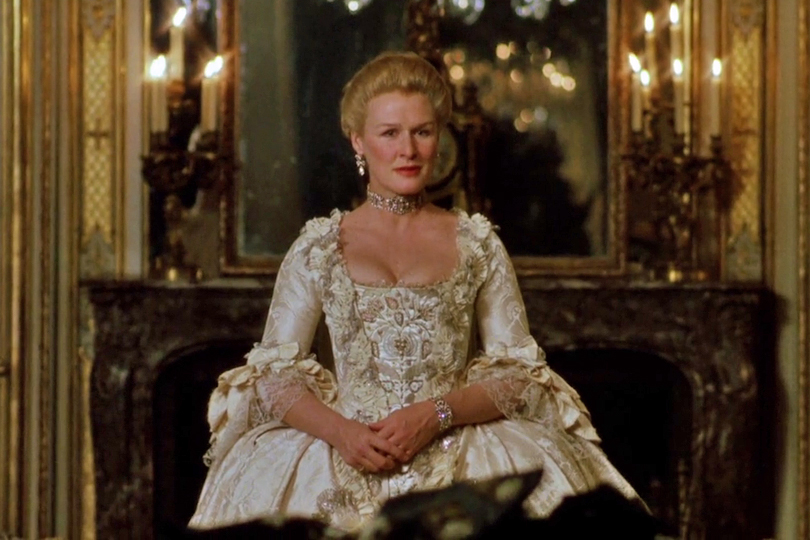
The award-winning costumes featured in Dangerous Liaisons were designed by British costume designer James Acheson, who won his first Academy Award for his breathtaking designs for The Last Emperor (he repeated that feat the following year with Dangerous Liaisons, and later earned a third Oscar in 1995 for Restoration).
“I’d also like to thank the wonderful group of actresses that withstood the rigours of 18th century corsetry with such patience and good humour,” Acheson said while accepting the award for Best Costume Design for Dangerous Liaisons.
At the time, Acheson was praised for his historical accuracy. For the 1988 film adaptation of Dangerous Liaisons, Acheson wanted to set the costumes firmly in the 1760s, with lots of ruffles, laces, trims, laced-up corsets and wide hoops. “Glenn Close was corseted to within an inch of her life,” Acheson told The Guardian in “Dresser To The Stars” on March 6, 1989.
Of course, Close had some thoughts about wearing a corset, which she gave in Art of the Character: Highlights from the Glenn Close Costume Collection: “The corset was incredibly important as far as movement and class,” she said, calling it “confining.” She went on to say, “The costumes totally informed the way I moved. I wanted to look as if I were gliding when I walked, playing against the tight corset. Merteuil is a proud aristocrat and should radiate elegance, class and control.”
One of the standout gowns in Dangerous Liaisons that helped secure Acheson’s win is an ivory brocade robe à la française, or a sack-back gown (which was the dress of the 1740s through the 1760s). It has a cleavage-crushing bodice and an exaggerated box-like waist, and features a variety of embellishments, sequins and floral embroideries as well as pleated ribbon appliqués on the skirt and on the bodice. Close’s character, the Marquise de Merteuil, wears the gown towards the end of the film, first in a scene at the opera and again in her home when she has her final confrontation with Malkovich’s character, Valmont.
Just less than two years after Dangerous Liaisons was first released in theatres, the ivory robe à la française from that high-tension scene was ready to make another high-profile appearance.
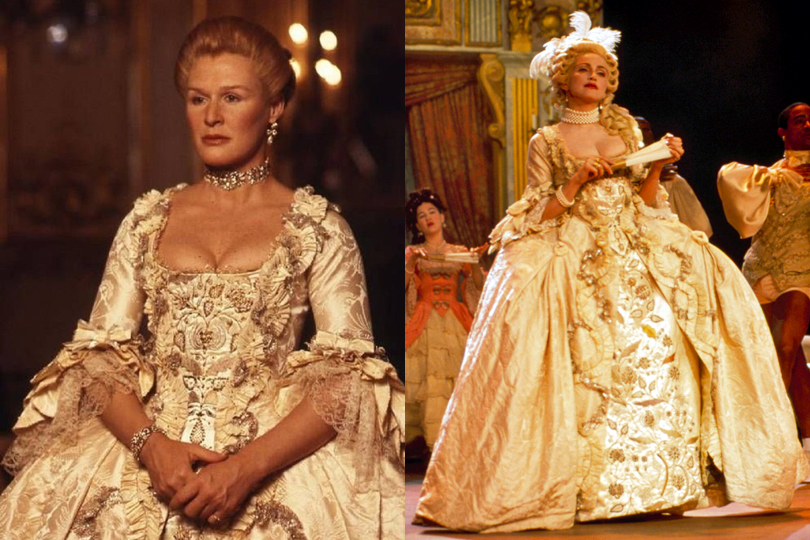
The VMAs
Madonna wore the same dress Close had worn in Dangerous Liaisons for her own Marie Antoinette-inspired performance of “Vogue” at the 1990 MTV Video Music Awards, which were held at the Universal Amphitheatre in Los Angeles on September 6, 1990. Madonna had the distinction of being the most nominated artist of the night, as her video for “Vogue” had received nine nominations, making it also the most nominated video of 1990. She ended the night with three technical awards (Best Direction in a Video, Best Editing in a Video, and Best Cinematography in a Video).
Madonna, accompanied by the dancers from her Blond Ambition Tour, closed the awards ceremony with a lip-synced performance of “Vogue,” which featured much of the same choreography from the just-wrapped tour. However, now the stage featured an opulent and aristocratic aesthetic straight out of 18th century France, and Madonna emerged on stage in the likeness of a pale Marie Antoinette in an extravagant court dress (that was properly corseted), pearls, and a huge white blonde wig topped with swan feathers. Her two backup singers and dancers portrayed her court and paraded around the stage in 18th century-inspired finery. The performance topped the much-loved tour performance of “Vogue,” and dazzled the audience with a flawlessly executed dance routine complete with fan clacking and a moment of nail-biting precision when the fans are flipped mid-air and caught on the beat. The performance made headlines around the globe; while some people called it an “oversexualized” performance with Madonna’s breasts getting much of the attention, most were blown away by it. In the days that followed, it went viral – at a time before these types of things went viral.
Madonna’s glamorous, nonchalant performance as Marie Antoinette cemented her status as MTV’s greatest star. Reflecting on the performance itself, Lucy O’Brien, author of Madonna: Like an Icon (2007), described it as a “moment of inspired brilliance,” while fellow Madonna biographer Taraborrelli called it a “classic, camp show that elevated the standards of future performances.”
The “Vogue” performance, Madonna’s Dangerous Liaisons costume and the elaborate costumes the dancers wore on stage that night were unlike anything ever seen on the MTV stage – but there are conflicting reports about where the idea for the performance and the elaborate costumes came from.
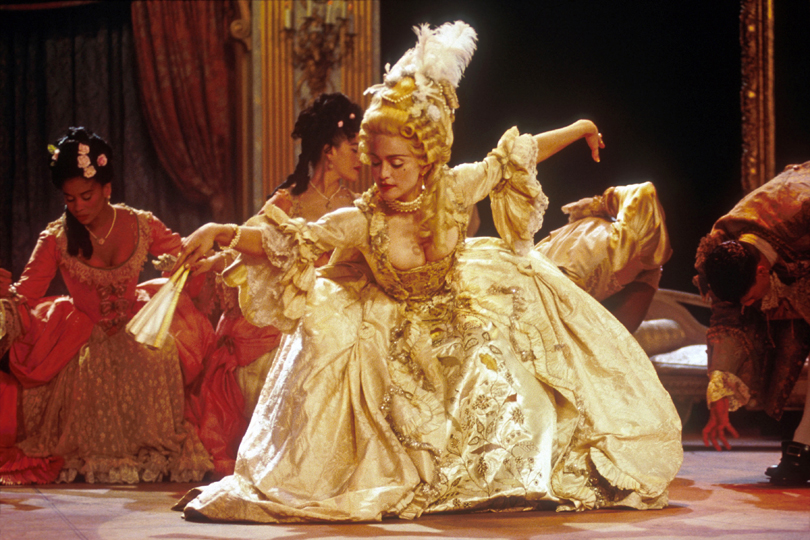
The next night, Madonna and company repeated their Marie Antonette performance at a benefit for AIDS Project Los Angeles, held at the Wiltern theatre, and received a seven-minute standing ovation before Madonna was honoured for her contributions to AIDS-related causes.
Everyone’s a genius…
Vincent Paterson, who was co-director and choreographer of Madonna’s Blond Ambition World Tour (which toured around the globe from April 13, 1990, until August 5, 1990) gave an interview with ANALOGr in 2022 about his role in the iconic performance and about the three cloth fans that had been used by Madonna and her longtime backup singers, Donna De Lory and Niki Haris, during the MTV performance.
Madonna’s first thought, he said, was to have the male dancers in skirts, with Madonna in a man’s suit – but Paterson said that had been done before. Then, he recalled, “I went into a little studio and I took these fans and I don’t know why.… It was, again, as I said in my book called Icons And Instincts, it was an instinct. I thought, ‘I bet I could do something fun with these fans,’ so I got in there and I started to play and I just started to think about it, and all of a sudden the idea popped into my head that voguing was not that much different than the court gestures of Marie Antoinette’s court and the way they posed and the way they held themselves and the various sort of situations that they would create with their physicality. And I thought, ‘Wow, what if Madonna was dressed like Marie Antoinette and the girls were dressed like her female courtiers and the guys were all dressed like members of the court – it would all make sense.… I showed [Madonna] preliminary moves of what I had done with the fans and the voguing, and she fell in love – and the rest is history.”
José Guitérrez and Luis Camacho, both of the House of Xtravaganza in New York, tell the story a little differently. It’s important to note that this dynamic duo had originally taught Madonna how to vogue after she first saw the guys dancing at the Sound Factory in New York. They showed off their voguing skills in the black-and-white “Vogue” video, travelled the world as dancers on the Blond Ambition Tour and took part in the VMA “Vogue” performance. They spoke to TV Insider back in 2015 about the performance.
According to Guitérrez and Camacho, the idea to style the performance à la pre-Revolution France came during a game of charades on the final leg of the Blond Ambition Tour, in Nice. One of the charades was Dangerous Liaisons, and Madonna pointed out how similar it was to voguing. “Voguing is very arrogant and very aristocratic with all this attitude,” Guitérrez explained, “so I think the theme and the costumes made us emulate it even more.”
The night of the awards show, they knew by the time they went on stage that they hadn’t won their own award for best choreography. Camacho recalled, “Standing offstage, José and I felt like, ‘We are about to show you why we should have gotten that award!’” Added Guitérrez: “You can see our energy. It’s that moment when the curtain goes up and we are there, and everyone in the crowd just rises to their feet. I was jumping out of my skin.”
It certainly wasn’t as easy as they made it look. As Camacho recalled, “The only thing that had us a little nervous were the fans the women [dancers] had. At one point in the choreography, they flipped the fans in the air, and they’re supposed to catch them. At almost every rehearsal, somebody would drop the fan.… And no one dropped a fan! After they all caught it, we all clapped and breathed a sigh of relief. It was a nail-biter.”
“Talking about it now is like reliving those moments of being on stage,” Guitérrez said. “It gives you this rush of wanting to be the best and wanting to leave such an impression. It’s crazy because 25 years later, people still remember. I still get recognized on the street from this job that I did 25 years ago, and it feels so good.”
Need yet another version of the story? Marlene Stewart, Madonna’s former costumer, opened up to Today about the backstory surrounding the iconic performance during an interview back in 2020. Stewart, who started her career in fashion by working in the garment industry, designed for the pop star from approximately 1984 to 1992 before later working more heavily in the film industry.
“We know historically that the French were the biggest posers, and it’s the whole idea of voguing and posing,” Stewart explained of her inspiration for the costume. “So it was the perfect transition. I suggested this kind of French court situation with Marie Antoinette. It’s really one of the origins, right? All they did was, ‘Strike a pose.’”
When asked if it was her idea, she said it was, but then added, “I think one always has to say it’s a collaboration. I would never say anything was completely mine. Every time you work with an artist, you work on something together.
“It’s a team effort. You can’t do anything by yourself.”
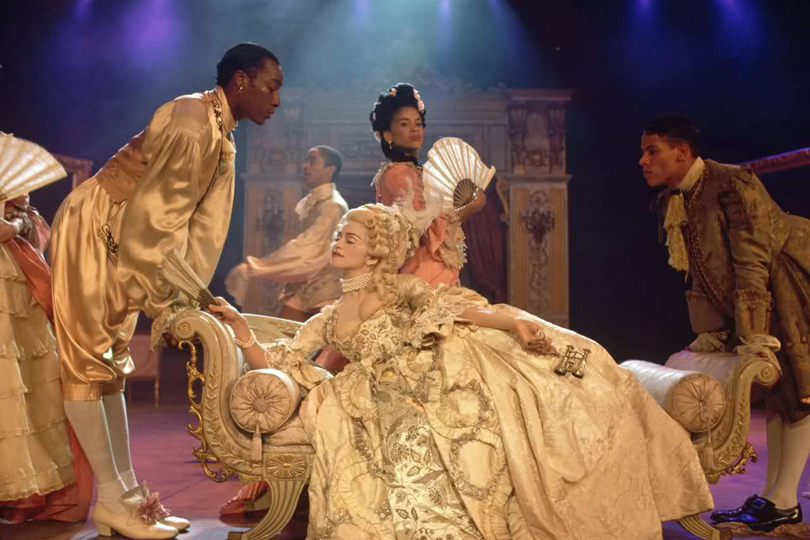
Changing the pop landscape forever
Despite the varying stories about where the idea for the costumes and Dangerous Liaison-like rendering of “Vogue” came from, one thing is clear: someone in Madonna’s entourage was friends with Acheson and was able to borrow one of the costumes that Close wore in Dangerous Liaison for the MTV performance. Another thing that is clear: the just-over-six-minute award show performance is a career highlight for Madonna, and a changing point for MTV. It’s a camp, over-the-top performance that would shape the future of award show performances, especially on MTV, and is still referenced as one of the most iconic performances in the history of award shows.
It is also the moment Madonna truly became the master of reinvention, grabbing the reins of an underground subculture and genre and pulling it into the mainstream, reinventing herself in the process and transitioning into the new decade with one of her biggest hits…all while corseted in a look straight out of the 1760s.
Now, “Strike a Pose.”
Want more? You can read other stories from our The Story Of series right here.

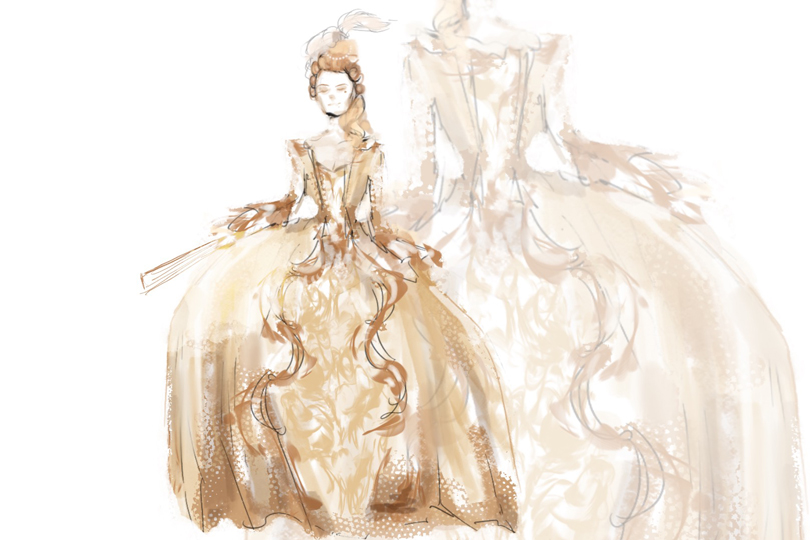
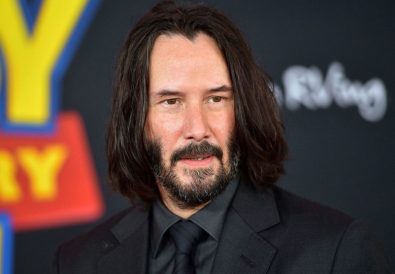

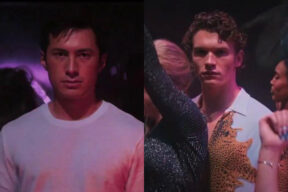


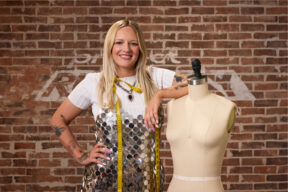

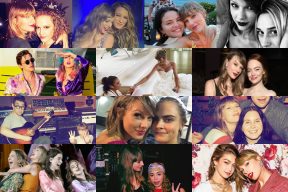

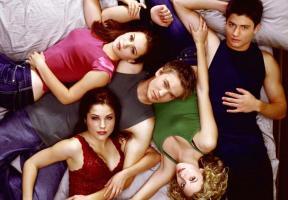
This is not a reference to Marie Antoinette but to Madame de Pompadour with Louis the 15th, according to the work “Les liaisons dangereuses”